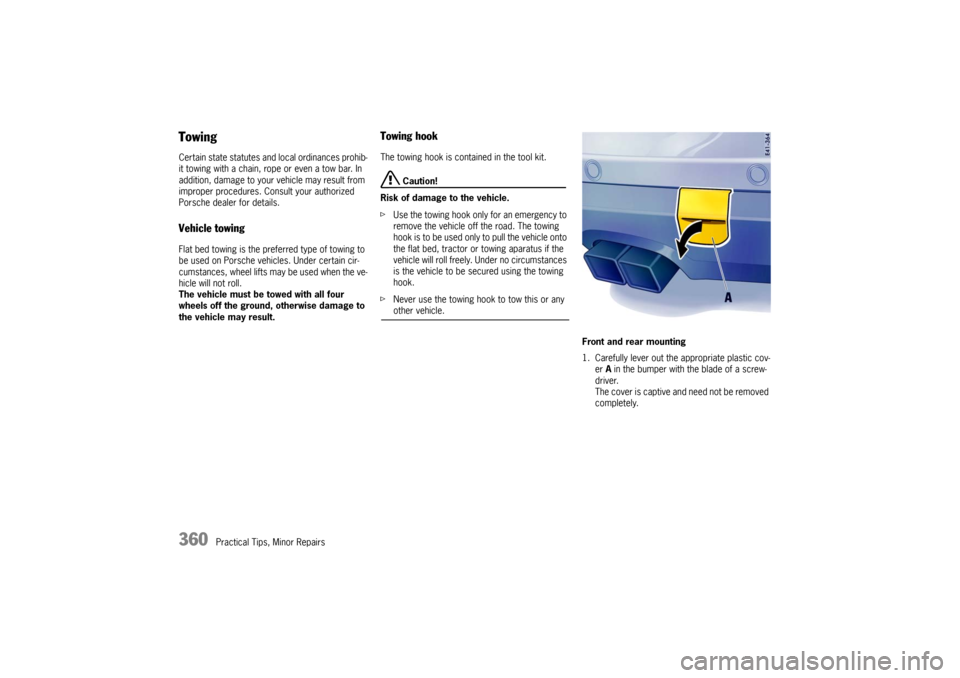four wheel drive PORSCHE CAYNNE TURBO 2006 1.G Owners Manual
[x] Cancel search | Manufacturer: PORSCHE, Model Year: 2006, Model line: CAYENNE TURBO, Model: PORSCHE CAYENNE TURBO 2006 1.GPages: 387, PDF Size: 8.44 MB
Page 11 of 387

Controls, Safety, Instruments
11 Controls, Safety, Instruments
Never invite car theft! .................................... 16
Keys ............................................................ 17
Remote Control ............................................ 20
Porsche Entry & Drive ................................... 22
Central Locking System................................ 24
Doors .......................................................... 27
Alarm System,
Passenger Compartment Monitoring, Inclination
Sensor ......................................................... 28
Power Windows ............................................ 33
Front seats................................................... 36
Front seat with memory................................. 37
Easy Entry Function ...................................... 39
Headrests .................................................... 40
Rear Seats ................................................... 41
Heated Seats – Front and Rear ...................... 44
Safety Belts.................................................. 46
Airbag Systems ............................................ 50
Child Restraint Systems ................................ 55
Child Restraint Anchorages ............................ 61
Steering Wheel ............................................. 62
Multi-Functional Steering Wheel ...................... 64
Interior Mirror ............................................... 66
Door Mirrors................................................. 67
Automatic Anti-Dazzle Mirror .......................... 69
Ignition Lock/Steering Lock ........................... 70
Starting and Stopping the Engine ................... 72
Parking Brake ............................................... 74
Brakes ......................................................... 75
Instrument Panel USA Models ........................ 80
Instrument Panel Canada Models.................... 82
Oil Temperature Gauge................................. 84Speedometer ............................................... 84
Cooling System ............................................ 85
Fuel ............................................................. 86
Odometer..................................................... 87
Emission Control........................................... 88
Multi-Purpose Display.................................... 90
Warning Lights and Warning Messages ......... 122
Light Switch ............................................... 130
Instrument Illumination ................................. 132
Automatic Headlight Beam Adjustment ......... 132
Turn signal/High Beam/Headlight Flasher Stalk ...
133
Emergency flasher ...................................... 134
Windshield Wiper/Washer Stalk .................... 135
Cruise Control ............................................ 138
Vents ......................................................... 141
Fresh-air intake ........................................... 141
Heated Rear Window ................................... 142
Automatically Controlled Two-Zone Air Condi-
tioning ....................................................... 143
Automatically Controlled Four-Zone Air Condi-
tioning ....................................................... 147
Parking Heater............................................ 153
Sun Visors .................................................. 158
Sun Blinds, Rear Side Windows .................... 159
Interior Lighting .......................................... 160
Door-Surrounding Lighting ........................... 162
Coming Home Function (Auto Shut Off Delay) 162
Sliding/Lifting Roof ..................................... 163
Parking Aids ............................................... 173
Garage Door Opener ................................... 178
Ashtray ...................................................... 181Cigarette Lighter ......................................... 182
Car Audio Operation/Tips ............................ 183
Porsche Communication Management (PCM). 186
Fire Extinguisher ......................................... 187
Storage...................................................... 188
Cupholder .................................................. 192
Rear Lid ..................................................... 194
Rear Window .............................................. 196
Loadspace ................................................. 197
Luggage Compartment Cover ...................... 198
Engine Compartment Lid ............................. 199
Luggage Safety Net ....................................201
Ski Bag ...................................................... 203
Roof Transport System................................ 205
Trailer Coupling .......................................... 206
Loading Information ....................................207
Page 100 of 387

100
Controls, Safety, Instruments
Tire PressurefPlease observe the chapter “TIRES/WHEELS”
on Page 285.
The tire pressure monitoring continuously
monitors tire pressure and tire temperature on all
four wheels and warns the driver when the tire
pressure is too low.
The display as well as the settings for tire
pressure monitoring are done on the multi-
purpose display in the TIRE PRESSURE menu.
However the tire pressure must be set manually
on the wheel.
The tire pressures to be monitored for tire type
are permanently set in the tire pressure
monitoring and cannot be changed.
The driver is solely responsible for filling the tires
correctly and for selecting in the multi-purpose dis-
play.
Danger!
Risk of serious personal injury or death.
Driving the vehicle with low tire pressure in-
creases increases risk of a tire failure and re-
sulting loss of control. Furthermore, low tire
pressure increases rate of wear of the affect-
ed tires.
Despite the advantages offered by the tire
pressure monitoring, it is not a substitute for
proper tire maintenance, and it is the driver’s
responsibility to maintain correct tire pres-
sure, even if under-inflation has not reached
the level to trigger illumination of the tire
pressure monitoring low tire pressure mes-
sage.
fWhen a flat tire has been displayed, immediate-
ly stop in a suitable place and check the tires
for damage. If necessary remedy the damages
with tire sealant.
fDo not by any means continue to drive with
leaking tires.
fDefective tires must be immediately replaced
by a specialist repair shop.
Tire repairs are not permissible under any
circumstances.
fSealing the tire with the tire sealant is only an
emergency repair, so you can drive to the next
repair shop. The maximum permitted speed is
50 mph (80 km/h).fDo not drive with tires whose tire pressure
drops again in a short period of time. In cases
of doubt, have tires checked by a specialist re-
pair shop.
fIf the tire pressure monitoring is defective
(e.g., defective wheel transmitter), contact a
specialist workshop immediately and have the
damages repaired.
The tire pressure will not be monitored by a de-
fective tire pressure monitoring.
fTires lose air over time without a tire defect be-
ing present. A tire pressure warning will then
appear in the multi-purpose display. Correct
the tire pressure at the next opportunity.
fThe tire pressure monitoring gives a warning
about tire damages due to insufficient tire
pressure as well as about a gradual loss of
pressure due to foreign objects.
The tire pressure monitoring cannot warn you
about tire damages occurring suddenly (e.g.,
flat tire due to sudden external effects).
fBefore fitting tires approved by Porsche which
are not stored in the on-board computer, the
missing information should be supplemented
in the on-board computer.
Page 228 of 387

228
Shifting Gear, Traction Systems
Porsche Traction Management (PTM)Porsche Traction Management is a full-time all-
wheel control system designed to influence the
longitudinal and lateral dynamics. It is closely
linked with the Porsche Stability Management
(PSM) system:
PTM ensures the best possible power distribution
to the four driven wheels at the front and rear ax-
les. The system realises this optimal traction by in-
tervening in the lock control function of the trans-
fer case and rear differential. PTM is active at all
times and, unlike the PSM, cannot be switched off.Advantages of PTM
– Obvious improvement in traction, driving stabil-
ity and steering ability of the car.
– Vehicle is more manageable when driven at its
performance limits.
– Improved straight-ahead tracking and stability.
– The aforementioned features allow for a sport-
ier setup of the running gear.
– The TCS and ABD provide even better traction
for all wheels.
Warning!
In spite of the advantages of PTM, it is still the driv-
er’s responsibility to adapt his/her driving style
and maneuvres in line with road and weather con-
ditions, as well as the traffic situation.
The increased safety that is provided should not in-
duce you to take greater risks with your safety.
The limits set by the physics of driving cannot be
overcome, even with PTM.
Risks of accident due to inappropriate speed
cannot be reduced by PTM.
Page 229 of 387

Shifting Gear, Traction Systems
229
Full-time all-wheel drive
With the four-wheel drive, the drive power is varia-
bly distributed to the front and rear wheels.
Power distribution and wheel speed compensation
between the front and rear axles is realised with a
transfer box.
Distribution of the drive power depends on the
wheel speed difference between the two axles.
The transfer box always controls power distribu-
tion in such a way that optimal propulsion is
achieved, even on an unfavorable road surface.
Full-time four-wheel drive ensures optimal handling
and great stability.
Warning!
In spite of the advantages of four-wheel drive, it is
still the driver’s responsibility to adapt his driving
style and maneuvers in line with road and weather
conditions, as well as the traffic situation.
The increased safety that is provided should not in-
duce you to take greater risks with your safety.
The limits set by the physics of driving cannot be
overcome, even with four-wheel drive.
Risks of accident due to inappropriate speed can-
not be reduced by four-wheel drive.Automatic brake differential (ABD)
The ABD system controls the front and rear axles
separately. If one wheel of an axle starts to spin,
it is braked so that the other wheel on the same
axle can be driven.
The ABD recognises different driving states, and it
features control strategies adapted to these
states. In situations in which little propulsive power
is required, such as when the car moves off on a
level gravel surface, traction control already be-
comes active at low engine speeds. If great
propulsive power is required, e.g. when moving off
on an uphill slope or for rapid acceleration, the
ABD is adapted accordingly.
A special off-road program is used in Low Range
mode.Traction control system (TCS)
The traction control system prevents the wheels
from spinning by adjusting the engine power,
thereby ensuring good lane-holding ability and a
stable driving behavior.
Page 235 of 387

Shifting Gear, Traction Systems
235
Engine Braking Support
(Assistance when heading downhill)The Porsche Down-Hill Assistant is an assistance
system which helps the driver at slower downhill
driving up to approx. 12 mph (20 km/h), e.g., on
steep slopes or on wintry mountain roads.
As long as the accelerator pedal is not used when
traveling downhill, the Porsche Down-Hill Assistant
is active and brakes the vehicle.
The braking ability of the Engine Braking Support
is affected by slippery surfaces (e.g., on icy or
loose surfaces), like all brakes.
If road grip is lost on one or more wheels, the
system brakes the wheels which have good road
contact.
Warning!
Risk of accident. Reduced braking ability on
a slippery surface.
fAlways adjust your driving style to the driving situationConditions:
– The gas pedal must not be used when
travelling downhill.
– The speed must not
exceed 12 mph (20 km/h).
– The selector lever position D, M or R must be
engaged.
Tip on driving
The Porsche Down-Hill Assistant is active when
driving downhill either forwards or backwards.
Checks on test standsPower measurement
Power measurements on roller test stands are not
approved by Porsche.
Brake tests
Brake tests must be carried out only in High Range
and on plate-type test stands or roller test stands.
The following limit values must not be exceeded
on roller test stands:
– Testing speed 4.7 mph (7.5 km/h)
– Test duration 20 seconds
Parking brake test
Parking brake tests on the brake tester must be
performed only with the ignition switched off and
the selector lever in position N.Balancing wheels on the vehicle
During finish balancing of the wheels, the entire ve-
hicle must be lifted and the wheels must be free to
turn.
Dynamometer testing procedure Some U.S. states and Canadian provinces con-
duct emissions inspection/maintenance testing in-
volving the use of two-wheel dynamometer.
A two-wheeled dynamometer is a treadmill type
device upon which a single axle of the car, the driv-
ing axle of the vehicle, rotates to simulate vehicle
operation on the road while the vehicle remains
stationary.
Your Porsche Cayenne has a full-time four-wheel
drive system which cannot be disabled. Severe
d a m a g e t o t h e p o w e r t r a i n c a n re s u l t i f t e s t e d o n a
two-wheel dynamometer.
Warning!
To avoid severe powertrain damage and a
possible unexpected movement of the vehi-
cle.
fYour Porsche Cayenne vehicle must never be
tested on a two-wheel dynamometer.
fAdvise the emission station of this warning be-fore testing the vehicle.
Page 360 of 387

360
Practical Tips, Minor Repairs
TowingCertain state statutes and local ordinances prohib-
it towing with a chain, rope or even a tow bar. In
addition, damage to your vehicle may result from
improper procedures. Consult your authorized
Porsche dealer for details.Vehicle towingFlat bed towing is the preferred type of towing to
be used on Porsche vehicles. Under certain cir-
cumstances, wheel lifts may be used when the ve-
hicle will not roll.
The vehicle must be towed with all four
wheels off the ground, otherwise damage to
the vehicle may result.
Towing hookThe towing hook is contained in the tool kit.
Caution!
Risk of damage to the vehicle.
fUse the towing hook only for an emergency to
remove the vehicle off the road. The towing
hook is to be used only to pull the vehicle onto
the flat bed, tractor or towing aparatus if the
vehicle will roll freely. Under no circumstances
is the vehicle to be secured using the towing
hook.
fNever use the towing hook to tow this or any other vehicle.
Front and rear mounting
1. Carefully lever out the appropriate plastic cov-
er A in the bumper with the blade of a screw-
driver.
The cover is captive and need not be removed
completely.
Page 378 of 387

378
Index
IndexAABD ......................................... 227
, 229
, 231
ABS ......................................... 227
, 230
, 233
Off road ............................................. 234
Warning light ...................................... 233
After driving off road................................... 237
Aftermarket Alarms ..................................... 185
Air cleaner.................................................. 261
Air conditioning
Central vents ............................. 145, 151
Cover flap .......................................... 142
Disabling control panel (rear) ............... 148
Display ...................................... 143, 147
Footwell .................................... 145, 151
Four zone ........................................... 147
Fresh-air intake ................................... 141
Mono function ..................................... 144
Rear.......................................... 148, 152
REST mode ............................... 146, 152
Sensors ............................................. 142
Setting air quantity ..................... 144, 150
Setting temperature ................... 144, 149
Side vents ................................. 145, 151
Two zone ........................................... 143
Vents ................................................. 141
Windshield ................................. 145, 151
Air quantity
Setting ...................................... 144, 150
Air suspension ................. 174
, 191
, 227
, 244
Airbag ................................................. 50, 281
Disposal ............................................... 51Function ............................................... 52
Switching off passenger airbag ............ 123
Switching on passenger airbag ............ 123
Unit ...................................................... 62
Warning light......................................... 54
Air-conditioned areas
Rear................................................... 152
Air-conditioning compressor....... 143
, 146
, 151
Alarm button................................................. 18
Alarm system ...................................................
24
, 26, 28, 29, 30, 32, 34, 35, 206
, 322
Alcantara.................................................... 281
All-Season tires ........................................... 368
All-Terrain tires ............................................ 368
All-wheel drive ........................... 128
, 227
, 229
Anti-freeze content ...................................... 256
Anti-lock brake system .............. 227
, 230
, 233
Anti-roll bars
Disengageable .................................... 225
Armrest............................................. 188, 190
Assembly aid ..................................... 310, 319
Assistance when driving downhill .................. 235
Audio
Tips ................................................... 183
AUTO button .................... 143
, 144
, 147
, 149
AUTO LOCK ................................................ 118
AUTO UNLOCK ........................................... 118
Automatic anti-dazzle operation...................... 69
Automatic brake differential ....... 227
, 229
, 231
Automatic circulating-air mode ............ 145, 150
Automatic mode,
air conditioning ......................... 143
, 144
, 149Automatic transmission fluid ........................ 261
BBattery ......................... 70
, 72, 89, 186
, 332
After charging ..................................... 345
Car key .............................................. 346
Care................................................... 332
Charge state....................................... 332
Charging ............................................ 345
Installing ............................................. 342
Putting vehicle into operation ...............333
Removing .................................. 340, 341
Removing/installing .................... 335, 339
Replacing ........................................... 334
Warning light....................................... 125
Winter driving...................................... 333
Before driving off.................................12, 237
Belts ............................................................ 46
Fastening ............................................. 48
Height adjustment ................................. 49
Opening ............................................... 48
Tensioner ............................................. 47
Warning light.................................. 47, 60
Brake ...........................................................75
Booster ................................................ 77
Discs ................................................... 78
Pads .................................................... 78
Warning light......................................... 76
Brake fluid
Changing ............................................ 259
Brake light .................................................. 356